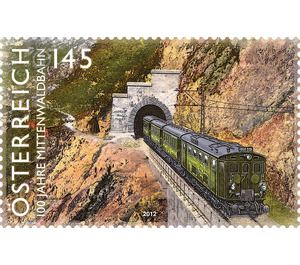100 years - Austria / II. Republic of Austria 2012 - 145 Euro Cent
Theme: Traffic, Transportation & Mobility
| Country | Austria / II. Republic of Austria |
| Issue Date | 2012 |
| Face Value | 145.00 |
| Edition Issued | 325,000 |
| Printing Type | combination printing |
| Stamp Type | Commemorative |
| Item Type | Stamp |
| Chronological Issue Number | 2356 |
| Chronological Chapter | OOS-OE2 |
| SID | 626793 |
| In 55 Wishlists | |
The Mittenwaldbahn, popularly known as the Karwendelbahn, is undoubtedly one of the most spectacular railway tracks in the Alps. It leads from Tyrol to neighboring Bavaria, more precisely from Innsbruck via Seefeld and Mittenwald to Garmisch-Partenkirchen. For the 100th anniversary of Mittenwaldbahn, Swiss Post now congratulates with its own special stamp; her motif shows, after the presentation of a historical postcard, a railway line in front of one of the most impressive stretches of the entire line, the Martinswand or the same-named tunnel. History: At the end of the 1880s, the engineer and contractor Josef Riehl put the k.k. Ministry of Trade and Economics, a project, which provided a route from Innsbruck first to Hall and then, after a turn and mainly in tunnels to Seefeld. In order to get the project, he took into account years of dispute over financing the project and risked a lot of money - with no guarantee that he would ever get it back. In the State Treaty of Austria-Hungary with Bavaria from November 22, 1904 finally the Mittenwaldbahn was considered. The plans for the Innsbruck-Reith section were completed in 1907, but with the advocates of a long-distance train along the Fernpass, there were even more disputes. When Riehl finally received the approval of the authorities for the construction of the Mittenwald Railway on the Austro-Hungarian side of the border, he formed for the construction of a working group with the contractor Wilhelm Carl von Doderer. The contract included all the facilities necessary for the operation of the railway - in addition to the construction of tracks, the land purchase, the vehicle fleet, the electrical equipment and the power plant on the Ruetzbach. The Bavarian part between Garmisch and Mittenwald, meanwhile, goes back to a commission in 1896 from the Municipality of Mittenwald to the "Localbahnactien-Gesellschaft" in Munich for the development of a railway project concerning the continuation of the Localbahn Murnau-Garmisch-Partenkirchen to Mittenwald. This route was put into operation on July 1, 1912, but initially only with steam locomotives, since neither the power plant nor the electric locomotives were finished; on the Austrian side, however, from October 28, 1912, on the other hand, drove immediately with electric drive. It is interesting that the Mittenwald Railway was one of the first high-voltage single-phase alternating current railways to have a major impact on the standards of electric railway operations in Central Europe. Today, the scenic route is of course still important in regional and tourism traffic, but the international long-distance traffic Munich-Innsbruck mostly uses the route via Rosenheim and Kufstein.


